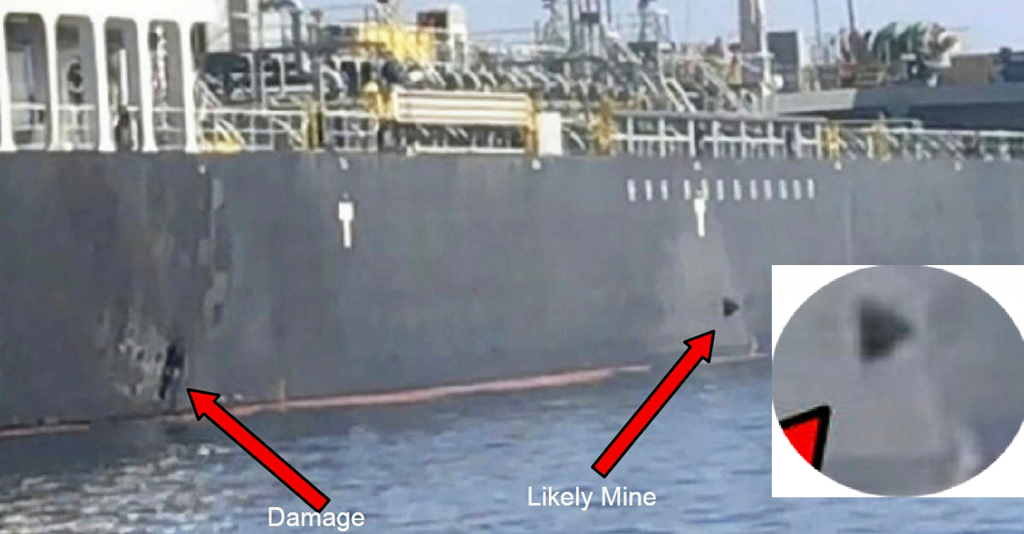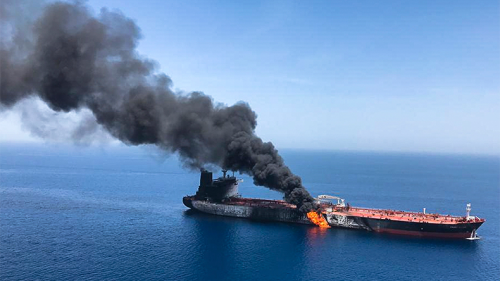On the 13th of Jun 2019 there were attacks on two oil tankers in the Gulf of Oman. The first took place at 2:12 UT against the ship, Front Altair, followed at 3:00 UT by an attack on the ship Kokuka Courageous. There were no fatalities. Neither ship sank, and all crew members were safely evacuated. The attack was immediately blamed by US authorities on Iran, with no evidence, amid what Iranian authorities claimed were highly suspicious circumstances.
The chart for the first event is below (bigger):

Since the attacks much of the world community is in disbelief of the claims made by US authorities, and for good reason, which we shall outline in due course. At the same time the internet is lit up with questions about a possible war with Iran and the similarities about the use of false information to manufacture consent for such a war. Having looked at this for some time and read of various analyses by military people, we can probably categorically say that a war with Iran is probably the furthest thing from a reality at this point. We will look at why that should be in due course as well. But first, we have the chart of this event, which in many respects is quite similar to the Fujairah incident a month ago. That piece is worth reading first if one is not familiar with what is going on here.
The first items we notice in the chart are the Sun in the 12th house (subterfuge, hidden enemies, secret agents) in Gemini (the quarreling brothers) square Neptune, the latter in Pisces (both indicating a maritime incident) conjunct the Midheaven, just behind in the 9th house (foreign actors). The Neptune/MC conjunction already speaks of deception or a lack of clarity, and there was plenty of the latter. The factor that is the real clincher of the chart, though, is the midpoint Sun=Neptune/MC, from Ebertin: “Physical disguise, the putting on of an act, the hiding of one’s character by the pretense of qualities which one has not got. – Discontentment with one’s occupation or work”. All that together says that this was another false flag attempt or operation. That is further indicated by what was going on in the days immediately before the attacks:
- There was a bill before the US Congress that would have passed barring Trump from sending billions of dollars in arms sales to the Saudis via proxies. Immediately after the attack the key swing votes changed their tune and instead supported some of the arms sales.
- Shinzo Abe was in Tehran for talks with the Iranians on the very day of the attacks. The Kokuko Courageous is a Japanese vessel, and Japan has had cordial relations with Iran since the Iranian Revolution. Abe is trying to cement his legacy and to possibly restore oil imports from Iran, seeking to smooth things over between the Trump White House and Iran. It was a long shot. Japan and Germany have both called for further investigations. And the Japanese captain of the vessel has countered Washington’s account of the incident.
- Just hours before the Gulf of Oman attacks, Yemen’s Houthis attacked Abha Airport in the south of Saudi Arabia with cruise missiles. The Houthis have upped the ante with Saudi Arabia and now threaten its infrastructure – and its livelihood.
- On the day before the attacks, the US House took up the 2020 $733B Defense Re-Authorization Bill. The bill passed the House Armed Services Committee that day.
Coincidences? Maybe. Like we saw with the Fujairah incident, though, it makes little common sense for the Iranians to have made these attacks. And then, there is the ‘evidence’ put forward by US authorities. We were shown a grainy video of what was said to be an Iranian boat removing a limpet mine from the hull of the Kokuka Courageous. First of all, it is helpful to be aware that limpet mines have to be installed by divers, meaning the ship has to be stationary. Secondly, they are designed to disable ships, not sink them, meaning they are normally placed below the water line near the propulsion or steering elements of a ship, not high above the water line. If there were limpet mines involved, they would have to have been installed at port, in Bahrain and the UAE, where they were loaded.
Then, there is the grainy photo of a ‘likely mine’ on the outer hull of the Kokuka Courageous, which doesn’t look like the outline of any sort of mine that one can find on the internet. Instead, it looks like a photo-shopped grey triangle, like one could do in the ‘Paint’ accessory in a Microsoft accessories program, seen below. So, why are we shown such grainy photos and videos as ‘proof’ when we have such high resolution cameras these days with telephoto lenses?

And lastly, the attacks on the ships were on the starboard sides of both vessels, which were on the UAE side of the ships. If the ships had been torpedoed or had missiles launched at them, those would have to have come from the Omani side of international waters. It is doubtful Iranian forces would have been there. All this points to a cover-up at least, and a false flag event at worst.
Why are these attacks taking place, then? The obvious conclusion is that there are four nations or factions who want a war with Iran – the neocons in the US, the Saudis, the UAE and Israel. But, if any of those four really want a war with Iran, they have to have the US fully on board, meaning the US public. The latter is unlikely, unless there were to be a 9/11 type of event. That, too, is unlikely in this present scenario. If there were to be a war – and this is why there will probably not be one – the following would happen:
- The Strait of Hormuz would close, cutting off 20% of the world’s oil supplies. No carrier will insure ships there in a war situation.
- Saudi and UAE oil infrastructure would be immediately targeted by Iran. I have heard estimates it would take 20 years to rebuild that infrastructure.
- American military installations throughout the region would immediately be targeted, such as Doha, Al Tanf, Saudi Arabia, etc.
- The Houthis would immediately step up their attacks on Saudi infrastructure.
- Hezbollah would unleash its forces on Israel, with 100,000+ precision guided missiles. No air defense would be able to defend against a barrage of such intensity, even if only a small fraction were to be launched at any one time. Israeli air bases would be the first to go.
- The world economy would collapse because of the disruption to energy supplies.
- Even if the Iranians and Hezbollah were largely defeated, a long and brutal guerrilla war would ensue which would keep the region destabilized for years at least, as well as oil production in the Middle East. That type of war would be taken into the heart of Israel.
- Terrorist attacks would sharply increase across the US and Europe, as well as in Israel and much of the Middle East.
- And then, it may seem a long shot to American readers (no pun intended), if the Iranians managed to sink or disable the aircraft carrier groups arrayed against them, with no air cover, American forces would be impotent in the region. It is not far-fetched. In fact, it is highly likely. The Iranians have highly developed and accurate anti-ship missiles now that they did not have even a few years ago.
As to the last point, how do we know this would happen? We go back to the 2002 Millennium Challenge, a war game that simulated an attack on a Middle Eastern nation, thought now to be Iran. The Iranians won, hands down, in the first simulation, with devastating results. It was over in ten minutes. The ‘Blue Team’ and organizers could not accept the results. It would not have fit the American narrative of overwhelming superiority. So, the game was re-jigged and run again. After severe constraints were place on the Iranian side when running the simulation a second time, the ‘Blue Team’ (allies) won, but even then it was not easy. The ‘Red Team’ (Iranians, probably) had to simply lay down and take it according to the new guidelines. That would not happen with Iran, especially now. We note that after that war game was run, there have been few to no Pentagon officials calling for attacks on Iran.
We can add to the preceding the fact that American influence in the region has been waning ever since the 2003 Iraq War. That war turned many of the states there against the US. The alliances that were in place in 2001 are now fractured. The US Central Command in Doha is now in enemy territory. Turkey, Iran and Qatar have formed an alliance, against NATO interests. the Axis of Resistance now also has a central, coordinated command, meaning they would all strike at once if any one of them were attacked in force. The logistics for launching a major war in the Middle East now simply are not there. Add to that the reluctance of European NATO members to enter into such a conflagration, and that would mean that Israel and the US would essentially have to attack Iran on their own. Save for a major 9/11-type of event, the American public would never support it.
The scenario just described is not my own. I have seen these views expressed in several knowledgeable sources, all mostly agreeing on the outcome. No one with any common sense or of decency would want such a war. Neither Trump nor the Iranians want war. That doesn’t mean there are not people who would not try to provoke one. However at the moment, wiser forces prevail.
But then, even if these events were only meant to send a message, they are having an effect. After both incidents (in May and June), oil prices spiked 4% higher. And after this latest one, the cost of insuring a tanker in the Gulf is now 10% higher. Look for prices to go higher at the pump, and possibly much higher, so long as this US administration keeps up its ‘maximum pressure’ on Iran. Such attacks on oil vessels will only accelerate.
And finally, as a result of Washington’s and Israel’s policies, Iran has developed a plan of its own into the future – its own plan of ‘maximum pressure’ on Washington, so long as the current program continues. But then, Iran has plans farther into the future, too. It has taken a leaf out of Russia’s book, apparently. Being a nation with Leo rising, it is seeking independence away from oil, away from any sort of ally. If you are curious, have a read of it here. This is going to be quite fascinating to watch over time.
In conclusion, get ready to pay more at the pump and for heating – maybe a lot more – if the maximum pressure from both sides continues. But for the moment, forget about that big war with Iran.
Featured pic from Lloyds List

